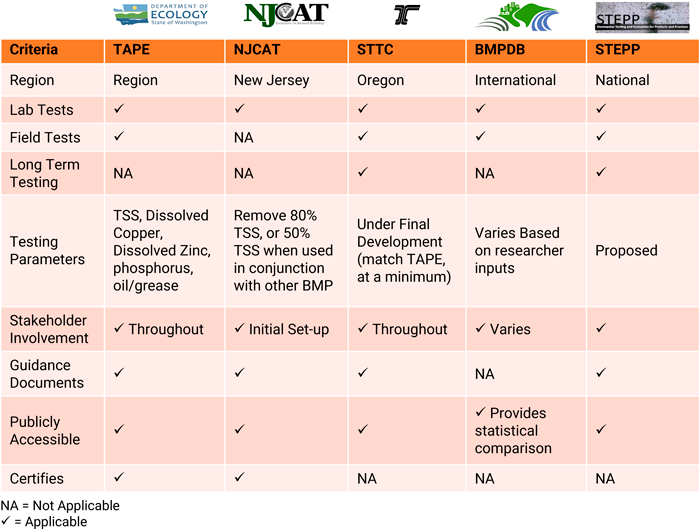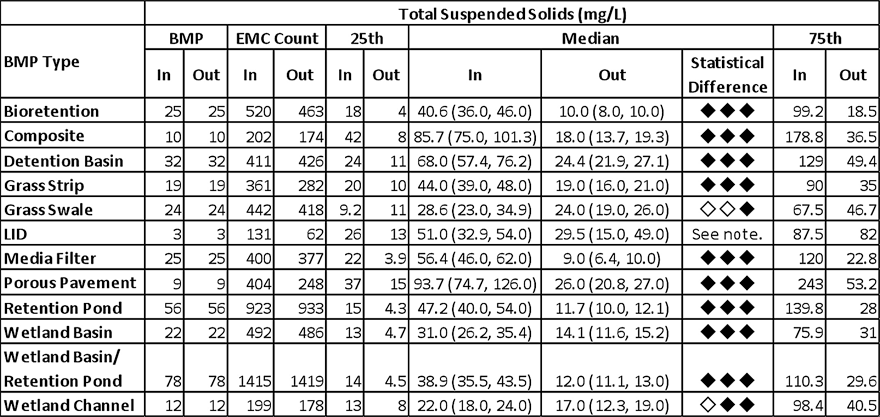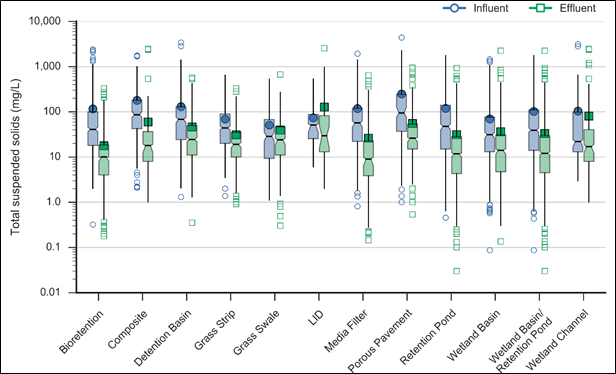2 Data Applicability
Data Resources and Intro to Screening Tool
This chapter includes information on former, existing and proposed stormwater performance data repositories and programs. Descriptions of the programs are included here to inform the user about what is available, not to direct anyone toward any particular program. To do a thorough review of any particular stormwater best management practice (BMP), it is useful to review information from as many programs as possible. This document recognizes this division of BMP types and focuses on the post-construction BMPs.
Outputs vary from each of the programs described below. The programs can be generally categorized as focused on field data, laboratory data or a combination of both. Some programs described in this section provide third-party verification and published monitoring data. The data collected for these programs followed specific protocols developed by their respective program. One program provides field data on stormwater BMP treatment capabilities in a central location available to all stormwater professionals.
Information from the data repositories listed in this chapter will assist engineers and regulators in assessing a stormwater BMP’s pollutant removal potential. In the next chapter, a BMP Screening Tool is presented to help the user access data from various sources for applicable stormwater BMPs.
2.1 Data Quality
This section describes basic protocols and procedures that engineers should use while measuring the effectiveness of stormwater BMPs. When using performance data to inform stormwater BMP selection, consider the level of testing that produced the data, including the protocols and procedures used (Figure 1-1). In general, BMPs that undergo a robust testing process will provide a higher level of confidence that the BMP will perform as expected. That is not to say the technology with a lower testing quality protocol will not be sufficient. However, the documented effectiveness may not be as reliable due to a less-robust data set.
2.1.1 Testing Protocols for Assessing Pollutant Removal Effectiveness
The use of well-defined protocols during BMP testing helps to ensure reliability that BMPs will remove the selected contaminants. Users should collect stormwater quality data to document the effectiveness of BMPs using a developed and standardized protocol. This minimizes variations that may occur through use of inconsistent sampling methodologies. Numerous BMP evaluation programs have developed testing protocols, such as the following:
- Washington State Technology Assessment Protocol – Ecology (TAPE) Program
- New Jersey Department of Environmental Protection (NJDEP)
- Technology Acceptance and Reciprocity Partnership (TARP)
- Georgia Technology Assessment Program (GTAP)
- S. Environmental Protection Agency’s (USEPA) Environmental Technology Verification (ETV) Program (discontinued)
- Environmental Technology Evaluation Center (EvTEC)
Other agencies, academia and BMP vendors have created independent testing and evaluation programs. The programs are similar in that they all use some standardized method to test and evaluate stormwater BMPs to provide water quality performance information.
2.1.2 Laboratories
There are two types of testing laboratories: one that does the actual performance testing of the unit and another that does the analytical testing of the samples generated during performance testing. A single lab may perform both functions but in this case it must meet the requirements of both types of laboratory. These requirements are outlined in the following sections.
2.1.2.1 Performance Testing Laboratories
Performance testing laboratories or hydraulics labs, generate, control and measure flow through stormwater BMPs. Hydraulics labs should maintain a regularly audited and documented quality system. The National Environmental Laboratory Accreditation Program (NELAP) or the International Organization for Standardization (ISO) can accredit these labs. The lab should follow an approved protocol for the actual testing. A Quality Assurance Project Plan (QAPP) details the protocol. The protocol can be a pre-existing publically available protocol such as NJDEP or TAPE, or it can be a specific protocol developed in consultation with the organization that will verify the results. An example of this is a Technology Specific Test Plan (TSTP) developed for the verification by the Canadian Environmental Technology Verification (CETV) program. A TSTP should contain all the elements of a QAPP, in addition to describing the proposed protocol.
2.1.2.2 Analytical Testing Laboratories
All analytical laboratories should follow standardized test methods (e.g., USEPA SW-846) and should be NELAP or ISO accredited and have appropriate accreditation for testing not covered under the NELAP certification. Accreditation is particularly appropriate for analytical labs. All laboratory samples should have the appropriate chain of custody and quality control documentation. Researchers should flag and further investigate samples that fail Quality Assurance and Quality Control (QA/QC) or violate hold times. Researchers should document any violations of the QA/QC program.
The user should review the results and the data quality issues to evaluate if the data are usable. Additionally, researchers should review the lab QA/QC protocols to ensure that they are appropriate for stormwater. Procedures that warrant special attention include sample spike/recovery procedures and method detection limit determination.
Many labs do work for other industries, which may dictate in-house sample spike/recovery procedures and use unreasonably high sample spikes. These may not accurately represent typical stormwater concentrations. Sample spike amounts should be consistent with the expected concentration of stormwater. A lab using a total nitrogen (TN) spike of 10 mg/L as Nitrogen (N) does not show the lab’s ability to recover concentrations as low as 1 mg/L as N and thus makes the reported results unreliable. This could also result in data that may be biased high (over reported) or low (under reported).
Method detection limits (MDLs), are the smallest amounts that a lab can routinely and repeatedly detect. For labs that work for other industries, total suspended solids (TSS) may not be a common test and there may be a tendency to report values based on the accuracy of the scale used in the weighing step, usually 0.001 g. This can lead to Total Suspended Solids (TSS) values of 0.1 mg/L or lower.
2.1.3 Field Data Quantity & Quality
The collection of stormwater samples from the field should be done under a controlled chain of custody according to the project-approved QAPP, or following the relevant sampling protocols established by the appropriate testing regulatory agency that will later review the data. Stormwater sampling points should be located to ensure that a representative sample of the parameter in question will be collected, (i.e., inflows, treated outflows). The sampling technique (e.g., grab, volume paced, time paced) used at any collection point should not change between storms to ensure consistency. Field sampling methods must minimize contamination potential and ensure proper sample preservation. A sufficient volume of samples should be collected so that the analytical laboratory can perform the requested testing, meet the approved laboratory test methods and allow for adequate laboratory QA/QC.
2.2 Historic Evaluation Programs
Various jurisdictions have implemented a number of programs to evaluate and/or store performance data and other stormwater BMP information. Unfortunately a number of these programs and are no longer active due to inadequate funding. These programs may still serve as a valuable source of credible performance data and other information useful in the design, operation and maintenance of stormwater BMPs. Prior to using data generated by one of these programs, users should understand the original intent of the program and the related protocols.
2.2.1 U.S. Environmental Protection Agency Environmental Technology Verification (ETV)
2.2.2 Technology Assessment Reciprocity Partnership (TARP)
2.2.3 The Massachusetts Stormwater Technology Evaluation Project (MASTEP)
2.2.4 The Canadian ETV (CETV) program
2.2.5 ISO 14034:2016 Environmental Management — Environmental Technology Verification (ETV)
2.3 Existing Data Verification Programs
Table 2-1 includes general information on the five existing programs discussed in this section.
View Table 2-1 in Adobe PDF format.

2.3.1 Technology Assessment Protocol – Ecology (TAPE)
The Washington State Department of Ecology (Ecology) manages three separate municipal stormwater general permits. Within the three permits are requirements for installation of water quality treatment BMPs on new and redevelopment projects. Depending on the water quality characteristics of the inflow to the BMP and receiving waters, the BMPs must meet certain criteria for removal of TSS, dissolved copper (Cu), dissolved zinc (Zn), total phosphorus (TP) and oil/grease.
In October 2002, Ecology released TAPE, the first version of the testing and evaluation protocol for BMPs. Ecology staff and volunteer experts provided the initial technical expertise. Ecology suspended the program for new applications between 2008 and 2011 due to the loss of available volunteer reviewers and Ecology staff. Ecology continued to review submittals from BMPs already in TAPE.
In late 2009, Ecology provided two grants to the City of Puyallup, to create a statewide stormwater center and to re-establish the TAPE program. Under the grant, Ecology created the Washington Stormwater Center and brought the TAPE program back to life. Ecology created a stakeholder advisory group (SAG) to assist in restarting the TAPE program and developing a new guidance manual and overview documents, which took approximately one year to complete. Ecology reopened the program for BMP testing and certification in late 2011.
The reconstituted TAPE program provides a peer-reviewed regulatory certification process for emerging stormwater BMPs. Ecology administers the TAPE program with assistance from staff at the Washington Stormwater Center, which provides assistance including guidance on certification of emerging stormwater BMPs.
Recognizing that an all-volunteer BMP evaluation process is unsustainable, Ecology and the Washington Stormwater Center established and paid a board of external reviewers (BER) comprised of stormwater experts including academia, regulators, consultants and manufacturers to:
- Review emerging BMP design and water quality performance data and resulting in a recommendation on whether or not to certify the BMP.
- Provide overall advice and guidance as the TAPE program evolves and improves.
Based on BER technical reviews, which include discussions with applicants as needed, Washington Stormwater Center staff members advise Ecology on whether a new stormwater BMP meets the state’s performance goals. Ecology adds BMPs that meet the water quality treatment goals to the list of approved BMPs in both of Washington’s two stormwater management manuals. Ecology makes the final decision to certify new stormwater BMPs.
Evaluation of BMPs is an important part of Ecology’s stormwater work, which is why Ecology prioritizes and is committed to maintaining the TAPE program.
2.3.1.1 TAPE Testing Protocols
2.3.1.2 Information Available to the Public
2.3.1.3 Benefits and Drawbacks
2.3.2 New Jersey Corporation for Advanced Technology (NJCAT)
2.3.3 Stormwater Technology Testing Center (STTC)
2.3.3.1 Testing Protocols
2.3.3.2 Information Available to the Public
2.3.3.3 Benefits and Drawbacks
2.3.4 International Stormwater BMP Database (BMPDB)
2.3.4.1 Testing Protocols
2.3.4.2 Information Available to the Public
2.3.4.3 Benefits and Drawbacks
2.4 A Future Data Verification Program
2.4.1 Testing Protocols
2.4.2 Information Available to the Public
2.4.3 Benefits and Drawbacks
2.5 Other Data Repositories
In addition to TAPE, NJCAT, STTC, the BMPDB, and STEPP, there are a number of other existing and proposed repositories for stormwater BMP information. Other sources include university research centers, independent organizations, state and regional environmental agencies, and industry literature. The following is a general description of the information presented with each of the listed source types:
- University research centers present findings from research of BMPs, specifically the water quality effectiveness and performance of those systems as well as maintenance requirements.
- State stormwater manuals provide information on suitable applications, design considerations, and maintenance requirements of stormwater BMPs and how they comply with specific states’ stormwater regulations.
- The “Other Organizations” category sources offers varied information. The Urban Drainage and Flood Control District (UDFCD) in Colorado offers a detailed stormwater manual similar to other state stormwater manuals. The Center for Watershed Protection (CWP) website contains an Online Watershed Library (OWL) with access to CWP publications and other resources (e.g., research papers, tools, and stormwater manuals) that support best practices in watershed and stormwater management.
- Industry literature presents new research findings on new stormwater BMPs as well as design and maintenance considerations for stormwater BMPs similar to the state stormwater manuals.
- Peer review literature, which may not be captured by other repositories
In addition to the state manuals listed, some states have Erosion and Sediment Control manuals and/or Department of Transportation (DOT) stormwater manuals.
2.6 Evaluating Data Repository Information
Once water quality performance data have been collected and made available for a specific BMP, whether manufactured, green infrastructure (GI) or a traditional land based practice, users can apply simple principles when evaluating the quality of data. This can provide regulatory agencies with guidance for the acceptance of new BMPs for inclusion within any local regulatory program. Please refer to Section 3.4 of this document for specific insight on utilization of available performance data for regulatory purposes.




